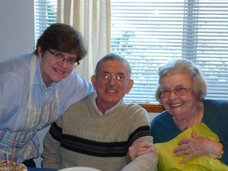The last week and half have been busy with work and dealing with Mom's ongoing medical issues. She called me at work last week to tell me she couldn't keep her breakfast down and had chest pains. I called her doctor immediately and consulted with her nurse. The choices were...bring her in that day or take her to the ER. I opted to take her in that afternoon because I knew the ER experience would be too much for her.
The doctor (not her usual physician) spent more time filling in information on her computer program than really listening to Mom. She told Mom that she needed to see a specialist as she probably had a blockage in her esophagus. I got on the phone right there in her office and made an appt. for the next day. It went fairly well with the new doctor...she did a much better job of listening to Mom and focusing on her. She goes back Nov. 27th for a procedure called an upper endoscopy.
Upper endoscopy enables the physician to look inside the esophagus, stomach, and duodenum (first part of the small intestine). The procedure might be used to discover the reason for swallowing difficulties, nausea, vomiting, reflux, bleeding, indigestion, abdominal pain, or chest pain. Upper endoscopy is also called EGD, which stands for esophagogastroduodenoscopy (eh-SAH-fuh-goh-GAS-troh-doo-AH-duh-NAH-skuh-pee).
For the procedure you will swallow a thin, flexible, lighted tube called an endoscope (EN-doh-skope). Right before the procedure the physician will spray your throat with a numbing agent that may help prevent gagging. You may also receive pain medicine and a sedative to help you relax during the exam. The endoscope transmits an image of the inside of the esophagus, stomach, and duodenum, so the physician can carefully examine the lining of these organs. The scope also blows air into the stomach; this expands the folds of tissue and makes it easier for the physician to examine the stomach.
The physician can see abnormalities, like inflammation or bleeding, through the endoscope that don't show up well on x rays. The physician can also insert instruments into the scope to treat bleeding abnormalities or remove samples of tissue (biopsy) for further tests.
Possible complications of upper endoscopy include bleeding and puncture of the stomach lining. However, such complications are rare. Most people will probably have nothing more than a mild sore throat after the procedure.
The procedure takes 20 to 30 minutes. Because you will be sedated, you will need to rest at the endoscopy facility for 1 to 2 hours until the medication wears off.
http://digestive.niddk.nih.gov/ddiseases/pubs/upperendoscopy/
National Digestive Diseases Information Clearinghouse
Subscribe to:
Post Comments (Atom)


No comments:
Post a Comment